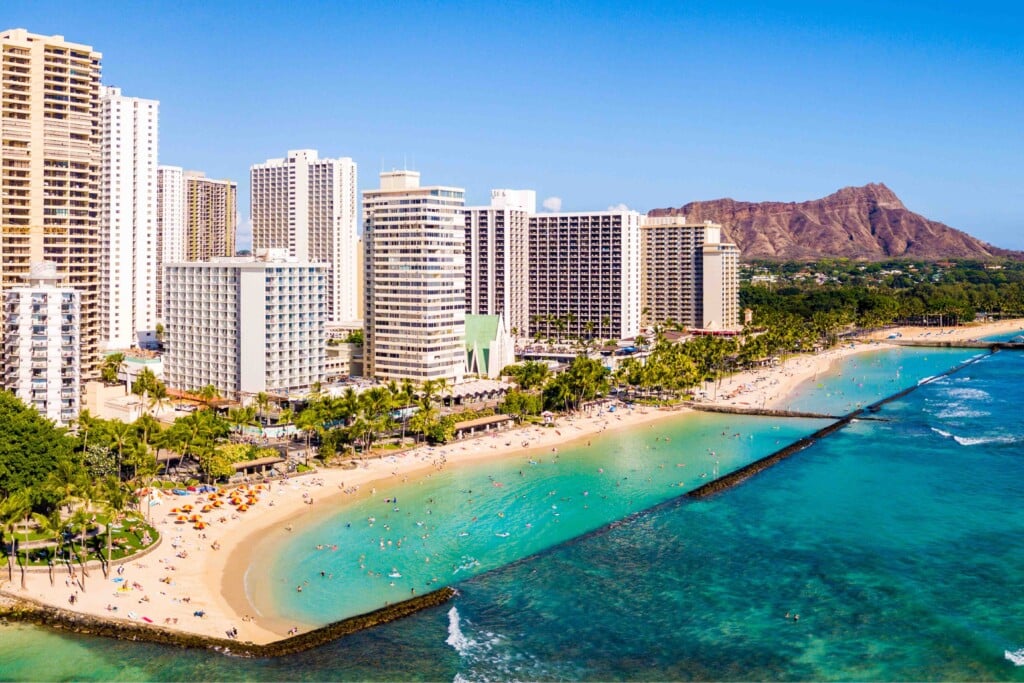For Them, It’s Hawai‘i 2.0
After years on the mainland, these locals are coming home – and bringing their thriving careers with them.

There’s no place like home, but what if “home” has become one of the most expensive places on Earth?
For years, the Islands’ high cost of living and fewer career prospects had convinced many in Hawai‘i to seek opportunities on the mainland. Now a lot of them are reconsidering that decision.
Paul Galindo, a locally born lawyer who practices in litigation, could be the poster child for how to successfully transition home.
Galindo got a phone call from an old law school classmate who works at a Honolulu law firm. This was when Galindo was near his breaking point after 13 years in Washington, D.C.
“After spending a warm, sunny, beautiful New Year vacation in Hawai‘i, my spouse and I knew that we were through with Washington, D.C., and its cold, rainy, windy, miserable 33-degree winter weather,” he says.
Galindo flew home to take the Hawai‘i bar exam (he passed the New York bar in 2010) and succeeded on his first attempt.
The Millennial attorney says his relocation home wouldn’t have been possible if he hadn’t already built and maintained a network of classmates and colleagues who could enable and support that return. Advances in remote work also helped.
For his part, Galindo’s husband, also a lawyer, works remotely from Honolulu.
Brain drain reversal
Galindo’s journey underscores a growing countertrend to the long-standing Hawai‘i-to-mainland brain drain: Working professionals on the continent are redefining their careers and reshaping their lives by coming home to the Islands.
Greater acceptance of remote and hybrid work has made the transition easier for many as have improved videoconferencing applications such as Zoom and Google Meets, cloud computing and project management software.
Indeed, in 2023, about 12,100 Hawai‘i-born individuals moved back to the state, while approximately 6,400 moved out, according to economist JoonYup Park of UHERO, the UH Economic Research Organization.
“This marks a reversal from pre-Covid trends, when more Hawai‘i-born residents were leaving the state than returning,” Park writes in the blog post “Who Is Moving In and Out? Understanding Migration Trends in Hawai‘i” (tinyurl.com/UHEROpost).
His study shows Hawai‘i has had a net gain in Island-born residents since 2021 – a trend that started during the Covid crisis when remote and hybrid work became the new normal for many professionals.
A large share of those returning home are 25 to 44 years old, which suggests that while many young people leave the Islands when they are 18 to 24 – often to attend college or start careers – many also return later.
In a follow-up interview with Hawaii Business Magazine, Park cites several reasons why people may have returned to Hawai‘i during and after the pandemic.
“The increased availability of remote work likely played a major role, especially at the height of the pandemic,” he says. “Another possible reason is the aging population in Hawai‘i – some may have returned to care for their parents or family members.”
Unfortunately, the data doesn’t tell us why people moved, only that they did, Park notes.

Kurt Osaki, FOunder of Osaki Creative Group, returned home a decade ago, and works from offices in Honolulu and Berkeley.
Working adults living on their own terms
Kurt Osaki is a UH graduate and globally recognized graphic designer who returned home with his wife a decade ago. He points out that younger generations, particularly Gen Z and Millennials, have increasingly prioritized work-life flexibility with hybrid schedules over traditional corporate structures and benefits.
“The younger generation is realizing the world is crazy right now. They are prioritizing health and mental well-being. They’re saying, ‘I’m going to be with my family and I’m going to enjoy life,’ ” Osaki says. “I think they’re being smarter in terms of how they approach their life as a whole.”
Osaki, founder of Osaki Creative Group, lives a hybrid life himself, residing in Hawai‘i but working from his offices in both Downtown Honolulu and Berkeley, California.
Galindo’s return to paradise with his husband underscores Osaki’s view about how some people are changing their ways of life: Galindo and his husband are savvy investors and savers. They are a part of the FIRE movement – financial independence, retire early – that is popular among Millennials and Gen Xers. The movement’s goal is for people to become financially independent by their 40s or 50s so they can retire if they wish and be freer to enjoy the rest of their lives.
“Shortly after graduating from law school, we knew that we didn’t want to wind up working 30 or 40 years in a legal career that would demand so much of our time, energy, weekends and youth,” he says.

Economist Joonyup Park of UHERO found that, in early 2023, nearly twice as many Hawaii-born people moved back to the islands compared to those that moved away.
Stemming Hawai‘i’s talent outmigration
For Hawai‘i-born Zack Hernandez, his return to O‘ahu was a no-brainer. Over a decade ago, the Punahou graduate received a scholarship to be team captain of Columbia University’s Division I wrestling team in New York City.
Between studying and sports, he was introduced to the world of Wall Street recruitment by a Columbia University alum who ran a talent-search firm. That exposure inspired Hernandez to choose the same career path.
“While I was in school, I picked up two years of experience and realized something that I wanted to do for the rest of my life. But how was I going to get back to Hawai‘i?” Hernandez asks.
His desire to return home became a personal mission. “With my background as a wrestler and a competitor, I felt that my next fight was to grapple with this talent brain drain and an age-old problem” in Hawai‘i, Hernandez says.
After moving from Manhattan to Seattle, Hernandez began beefing up his expertise in the recruitment and consulting business while working on building his own company, AEP Hawaii.
His firm specializes in building elite teams of executive, technology, finance and career professionals in Hawai‘i and the West Coast. AEP places local residents in high-paying jobs with its clientele of local companies and various startups, Department of Defense contractors and enterprises on the West Coast.
In Seattle, Hernandez ran a couple of recruiting firms. He also met his future wife, Gigi Dawn, then in business development for the NHL’s Seattle Kraken. They began planning their way to the Islands and after several years of running AEP between Seattle and Hawai‘i, they moved the entire company to O‘ahu a year and a half ago.
Along with supporting tech conferences and networking events – AEP was a founding sponsor of the first-ever Honolulu Tech Week – Zack Hernandez and Gigi Dawn are looking to help grow Hawai‘i’s “tech hub” community of web developers, engineers, technologists and executives.

Curt Kaneshiro, Principal at CTK Marketing Solutions, travels between Los Angeles and Hawaii to spend time with aging parents.
Pay transparency laws made a difference
Hernandez says two issues transformed Hawai‘i’s workforce landscape: remote work dynamics adopted during the pandemic coupled with pay transparency laws.
“When we saw Covid happen in 2020 and 2021, that’s when we first started to see local companies having to compete with remote opportunities,” Hernandez says.
In May 2020, 48.7 million people, about 35% of the employed workforce, reported they had worked from home in the previous four weeks because of Covid, according to the Bureau of Labor Statistics (tinyurl.com/BLSremote).
A McKinsey study (tinyurl.com/3fp5y2du) estimated that 29% of work in the U.S. could be done remotely with no productivity loss.
Another game changer for locals: transparency laws that attempt to reduce pay gaps, particularly the gender pay gap, by requiring employers to disclose salary ranges on job postings.
“Transparency laws also force companies to start paying folks higher, and that’s going to start levering up compensation. It’s going to start making folks realize that we have to be more flexible. These guys can be remote doing this job. Why do they have to commute for two to three hours from Wai‘anae into downtown?” Hernandez says.
“It’s the age of productivity, right? So for us, we’re looking at the companies who are the most forward-thinking companies that use technology.”
In September 2022 – during the height of corporate and government DEI initiatives – Gov. Gavin Newsom signed a new California pay transparency law that expanded already existing state transparency requirements. The law took effect in January 2023.
Hawai‘i’s pay transparency law went into effect Jan. 1, 2024; it requires employers with 50 or more employees to disclose hourly rates or salary ranges in job postings.
Overall, salaries in Hawai‘i tend to be slightly lower than the national average, with wages approximately 7% below comparable mainland averages. That is against the backdrop of Hawai‘i’s cost of living, the highest in the country.
“It comes down to pay,” Hernandez says about relocation. “A lot of folks are afraid to talk about compensation. It’s something that never really was talked about. It was taboo. With salary transparency laws, all companies have to put a range up, which is great, and I think that’s a good first step. We’re going to raise those ranges up to be comparable to other tech hubs. That’s super exciting for us.”
As an example, AEP Hawaii is hiring a remote senior machine learning engineer to join one of its startup clients, an early stage software as a service company. The base salary for the role – $180,000 to $200,000 plus equity – is closing the gap between Hawai‘i and mainland wages.
Coming home to care for family
UHERO’s Park says working adults are also considering returning home to care for elderly parents.
Curt Kaneshiro, principal at CTK Marketing Solutions, is a case in point. “The main reason I go back and forth to Hawai‘i from Los Angeles is because – maybe you’ve heard of this story too as you’ve been talking to locals – as you get to a certain age, your parents are also aging. So you want to get close to your parents and spend as much quality time as you can,” he says.
The aging demographics of Hawai‘i adds perspective to why working locals are returning home.
The U.S. Census Bureau’s American Community Survey (2019–2023) estimates that about 198,517 individuals in Hawai‘i are 70 or older – 13.8% of the total population. That aging population is raising alarm bells: The state is experiencing a faster increase in the proportion of residents age 65 and older than the national average – which has implications for caregiving, housing and social services as well as overall resources.
Kaneshiro says that while Hawai‘i is the most expensive state to retire in, it’s also appealing because of its balmy weather and calmer pace.
Using data from the Bureau of Labor Statistics and other sources, GOBankingRates this year calculated the minimum savings people need in order to retire and still afford essentials like housing, groceries, transportation, utilities and health care. If they’re collecting Social Security benefits but have no other income, they still need about $2.21 million in savings to retire in Hawai‘i for 25 years, according to GOBankingRates. In the next most expensive states to retire – Massachusetts and California – people need around $1.6 million in savings.
Kaneshiro says Covid became a pivotal period of self-reflection for many locals. “Hawai‘i has a very unique culture, which is why many who have moved away for education and career opportunities have the desire to eventually return to their roots. ‘Ohana is real and recent events such as the pandemic that have significantly impacted people have sparked an even greater desire for a life of comfort that only our cultural foundations can fulfill.”
Osaki echoes Kaneshiro’s sentiments. “Like many others who’ve lived away, I always carried a part of Hawai‘i with me. And over time, the desire to bring what I’ve learned back home became stronger. That’s what made coming back so meaningful,” he says. “It wasn’t just about returning. It was about a sense of kuleana – it was about reconnecting, contributing and giving back to the place that gave me my roots.”
Top 3 Reasons Locals Don’t Move Home
- Cost of Living – Hawai‘i is known for its beauty, balmy weather and gentler lifestyle, but it is also the most expensive state to live in, with housing especially costly.
- Limited Career Opportunities – High-paying positions are hard to come by in paradise when compared with many areas of the mainland. For instance, salaries across all industries in the San Francisco Bay Area are about 35%–50% higher, on average, than in Honolulu.
- Far From Everywhere Else = While folks often come home to be closer to family, many struggle with being far away from other loved ones on the mainland and overseas, and from some of the attractions and conveniences there. The nearest major cities are still more than five-hour flights away from the Islands.







